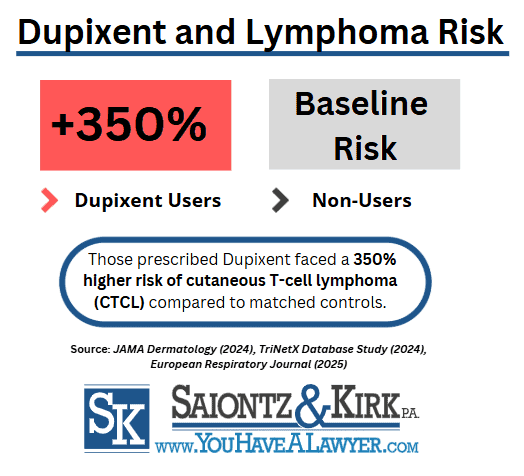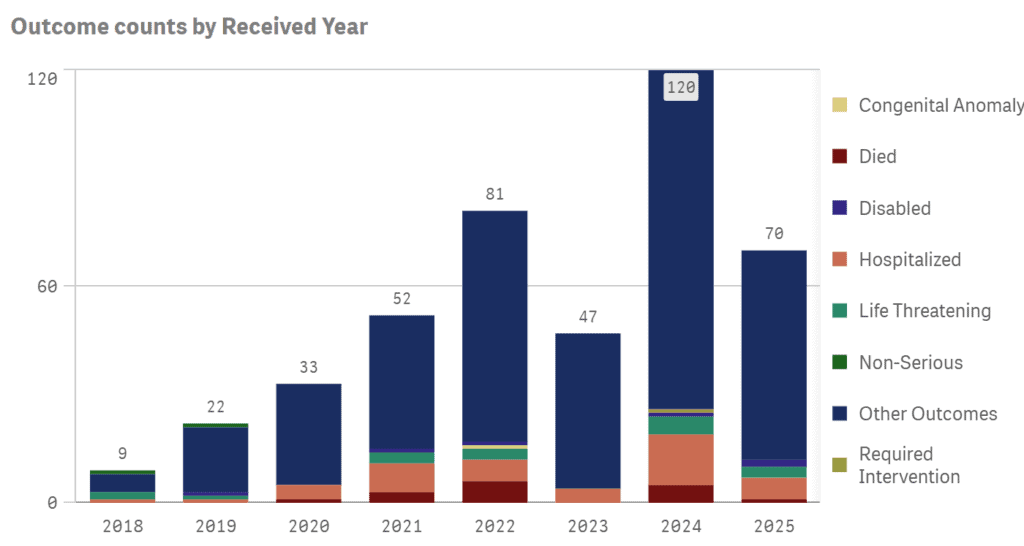Dupixent Lymphoma Lawsuit Overview
Dupixent lawsuits are being investigated over allegations that Sanofi and Regeneron placed profits ahead of patient safety, by failing to warn about the risk of rare and aggressive blood cancers linked to their medication.
Based on representations that Dupixent is safe and effective, this blockbuster biologic has been prescribed to millions of patients with eczema, asthma, and other chronic conditions. However, there is now mounting evidence that shows that Dupixent side effects may do more than calm inflammation — it may conceal or accelerate hidden lymphomas.
Studies have found that patients prescribed Dupixent face a 350% higher risk of developing cutaneous T-cell lymphoma (CTCL) and related cancers when compared to matched control groups. The Dupixent cancer side effects have been echoed across multiple large-scale analyses and case reports, all pointing to the same conclusion: Dupixent users may be left vulnerable to a cancer diagnosis that is both devastating and potentially avoidable.

Despite these red flags, Sanofi and Regeneron failed to provide adequate warnings to doctors and patients, leaving families blindsided when symptoms of cancer were mistaken for ordinary skin disease. For many, this meant precious time was lost before a correct diagnosis was made, while the cancer advanced unchecked.
The Dupixent lawyers at Saiontz & Kirk are reviewing claims nationwide on behalf of individuals who developed CTCL, Sézary syndrome, mycosis fungoides, or other T-cell lymphomas after using the medication. Patients and families may be entitled to pursue compensation for medical bills, lost income, pain and suffering, and wrongful death.

Who Can File a Dupixent Lawsuit?
You may qualify for a Dupixent lawsuit if you or a loved one were prescribed the drug and later diagnosed with a rare form of T-cell lymphoma. Dupixent lawyers are reviewing claims for individuals who:
- Were diagnosed with Cutaneous T-Cell Lymphoma (CTCL)
- Developed Mycosis Fungoides after Dupixent use
- Were diagnosed with Sézary Syndrome or another T-cell lymphoma subtype
- Experienced delayed or missed diagnosis of lymphoma because symptoms were mistaken for eczema
- Lost a loved one due to complications from a T-cell lymphoma diagnosis following Dupixent injections
For a free, confidential consultation, contact our Dupixent lawyers at 1-800-522-0102 or by filling out our secure online form.
Dupixent Lawsuit Info On This Page:
What Is Dupixent?
Does Dupixent Cause Cancer?
Dupixent Lymphoma Reports Ignored
Who Is the Dupixent Lawsuit Against?
What Allegations Are Raised in Dupixent Lawsuits?
What Compensation May Be Available Through a Dupixent Lawsuit?
How Long Do I Have to File a Dupixent Lawsuit?
How Can Dupixent Lawyers Help?
Are There Any Costs to Hire a Dupixent Lawyer?
How Do I Start a Dupixent Lawsuit?
What is Dupixent (dupilumab)?
Dupixent (generic name dupilumab) is a prescription biologic medication developed by Sanofi and Regeneron. It was first approved by the U.S. Food and Drug Administration (FDA) in 2017, as the first targeted biologic treatment for moderate-to-severe eczema (atopic dermatitis) in adults who did not respond to topical therapies.
Since then, the FDA has expanded Dupixent’s approvals to include treatment for:

- Atopic dermatitis (eczema) in adults and children
- Asthma with an eosinophilic phenotype or oral steroid dependence
- Chronic rhinosinusitis with nasal polyps
- Eosinophilic esophagitis (EoE)
- Prurigo nodularis
- Chronic obstructive pulmonary disease (COPD) with an eosinophilic phenotype
Dupixent is given as a subcutaneous injection, often every two weeks, and works by blocking IL-4 and IL-13 proteins involved in the body’s inflammatory response. For millions of patients, this has meant fewer flare-ups, less itching, and improved breathing.
However, despite being marketed as a safe, long-term therapy, side effects of Dupixent are now under investigation due to the potential link to rare and life-threatening blood cancers.
Does Dupixent Cause Cancer?
Over the last several years, peer-reviewed studies and medical case reports have raised serious concerns that Dupixent may be linked to an increased risk of cutaneous T-cell lymphoma (CTCL) and other blood cancers. While not every patient will develop cancer, the data show a pattern that cannot be ignored.
Research Linking Dupixent to Cutaneous T-Cell Lymphoma
- Dupixent Linked to 300% Higher Risk of CTCL: Patients with atopic dermatitis treated with Dupixent were found to have a 300% higher risk of developing CTCL compared to non-users (OR 4.10). Even after adjusting for demographics and excluding immune-suppressant use, the risk remained more than double. (JAMA Dermatology, April 2024)
- Dupixent Linked to 350% Higher Risk of CTCL: Researchers focusing exclusively on atopic dermatitis patients reported a 350% higher risk of CTCL among Dupixent users compared to matched controls (RR 4.59). These results reinforced the JAMA Dermatology findings. (TriNetX Database Study, August 2024)
- Dupixent Linked to 4.5-Fold Higher Risk of Lymphoma in Asthma Patients: Among asthma patients, Dupixent was associated with a 4.5-fold increased risk of CTCL compared to those treated with ICS/LABA therapy. For patients on Dupixent longer than 16 weeks, the risk of mature T- and NK-cell lymphomas climbed more than 14-fold. (European Respiratory Journal, June 2025)
- Case Reports Warn Dupixent May “Unmask” Hidden Lymphomas: Early case reports documented patients misdiagnosed with eczema whose cancers progressed rapidly after starting Dupixent. Dermatologists cautioned that the drug may mask lymphoma symptoms that mimic eczema, delaying proper diagnosis until the disease advanced. (JAAD, 2019–2020)
Dupixent Lymphoma Reports Indicate Manufacturer Ignored Concerns
In addition to peer-reviewed studies, evidence from the FDA’s own Adverse Event Reporting System (FAERS) supports the concerns raised in Dupixent lawsuits. FAERS collects adverse event reports from healthcare providers, patients, and manufacturers. While these reports do not prove causation, they are considered critical safety signals that manufacturers are legally required to review.
Lymphoma Cases Reported to the FDA
As of 2025, FAERS has logged more than 300 reports of lymphoma among Dupixent users dating back to 2018, including cases of cutaneous T-cell lymphoma (CTCL), Sézary syndrome, mycosis fungoides, and other rare blood cancers.
- Cutaneous T-Cell Lymphoma (CTCL)
- Unspecified Lymphoma
- T-Cell Lymphoma (general)
- CTCL, Stage IV
- Anaplastic Large Cell Lymphoma (T- and null-cell types)
- CTCL, Stage III
- Angioimmunoblastic T-Cell Lymphoma
- CTCL, Stage I
- Recurrent T-Cell Lymphoma
- Adult T-Cell Lymphoma/Leukemia
- Unclassifiable T-Cell Lymphoma
The steady pattern of these reports demonstrates that Sanofi and Regeneron were on notice of potential cancer risks, yet no meaningful warning updates were added to Dupixent’s label.

How FDA Reports Strengthen Failure-to-Warn Claims
Under product liability law, drug manufacturers are required to monitor post-marketing safety data and update their labeling when new risks emerge. The FDA’s Adverse Event Reporting System (FAERS) serves as one of the most important tools for detecting safety signals.
For Dupixent, the steady flow of lymphoma reports into FAERS provided a clear indication that patients were developing rare blood cancers after treatment. This means that Sanofi and Regeneron knew, or should have known about the potential dangers, yet failed to act.
Beyond lymphoma, the FAERS dashboard highlights how frequently Dupixent has been linked to serious outcomes:
- More than 360,000 total adverse event reports submitted for Dupixent
- Over 35,000 classified as “serious” adverse events
- Nearly 1,300 patient deaths reported in connection with Dupixent use
While these events are not limited to lymphoma, they underscore that Dupixent may carry a substantial risk profile.
Who Is the Dupixent Lawsuit Against?

Dupixent lawsuits are being pursued as product liability claims against Sanofi and Regeneron, the global pharmaceutical companies that developed and market the drug. The central allegation is that these companies failed to provide adequate warnings about the risk of developing cutaneous T-cell lymphoma (CTCL) and related cancers.
Failure to Warn Doctors About Lymphoma Screening
Dupixent (dupilumab) received its initial approval from the U.S. Food and Drug Administration (FDA) in March 2017, through the standard Biologics License Application (BLA) process. It was first cleared for use in adults with moderate-to-severe atopic dermatitis who had not responded to topical therapies. Since then, the drug’s approvals have expanded rapidly, including for asthma, chronic rhinosinusitis with nasal polyps, eosinophilic esophagitis, and other conditions.
However, with each expansion of Dupixent’s labeling, Sanofi and Regeneron had an ongoing duty to:
- Monitor post-marketing safety data, including adverse event reports submitted to the FDA FAERS database.
- Update warnings and prescribing information when new or emerging risks became evident.
- Provide physicians with guidance to screen or monitor patients for lymphoma before or during treatment.
By law, pharmaceutical companies must disclose risks that are known or should have been known based on available data. In the case of Dupixent, Sanofi and Regeneron failed to alert doctors that patients faced an elevated risk of lymphoma or that additional screening may have been necessary.
As a result, physicians prescribed Dupixent in good faith, unaware of the hidden dangers. Under product liability law, the duty to warn rests with the manufacturer, not the physician, making Sanofi and Regeneron legally responsible for the harm that followed.
Delayed Diagnosis of Lymphoma After Dupixent Use
Given that Dupixent’s labeling did not highlight the potential risk of lymphoma, many patients went undiagnosed until their disease had already progressed. A delayed cancer diagnosis often leads to more aggressive treatments, reduced survival rates, and significant pain and suffering. This creates a direct link between the manufacturer’s failure to warn and the injuries experienced by patients and families.
Allegations Raised in Dupixent Lawsuits
The Dupixent lawyers at Saiontz & Kirk are investigating claims for individuals who developed cutaneous T-cell lymphoma (CTCL) and other rare blood cancers after receiving Dupixent (dupilumab) injections. These lawsuits allege that the drug’s manufacturers, Sanofi and Regeneron, prioritized profits over patient safety and failed to warn about the risk of cancer.
Allegations Against Manufacturers
- Failed to disclose that Dupixent may increase the risk of T-cell lymphomas, including CTCL, mycosis fungoides, and Sézary syndrome.
- Marketed the drug as a long-term treatment option without adequate cancer monitoring guidance.
- Ignored or downplayed early case reports that Dupixent could “unmask” hidden lymphomas misdiagnosed as eczema.
- Failed to warn physicians that they should screen or monitor patients for lymphoma before prescribing Dupixent.
- Allowed labeling and promotional materials to suggest safety while omitting serious cancer risks.
- Continued to expand Dupixent’s FDA approvals and sales despite growing safety concerns.
What Compensation May Be Available Through a Dupixent Lawsuit?
Patients and families harmed by Dupixent may be entitled to pursue financial compensation through a product liability lawsuit against Sanofi and Regeneron.
While every case is unique, successful claims may provide compensation for:
- Medical Expenses: Diagnosis, cancer treatments, hospitalizations, and ongoing care.
- Lost Wages or Earning Capacity: Income lost from time away from work or reduced ability to continue employment.
- Pain and Suffering: Physical pain, emotional trauma, and diminished quality of life from a cancer diagnosis.
- Loss of Consortium: Damages for the impact on family relationships.
- Wrongful Death: Compensation for families who lost loved ones due to Dupixent-related cancers, including funeral expenses and loss of financial support.
How Long Do I Have To File a Dupixent Lawsuit?
Each state has a statute of limitations that sets strict deadlines for filing a drug injury or wrongful death lawsuit. In many states, this window is only one to three years from the time of diagnosis or death.
However, additional rules may extend or shorten that period depending on:
- When the cancer was diagnosed
- When the connection to Dupixent was discovered
- Whether the victim was a minor at the time of use
- State-specific wrongful death statutes
Since these deadlines vary and are strictly enforced, it is critical to speak with a Dupixent lawyer as soon as possible. Saiontz & Kirk can review your circumstances and help determine whether financial compensation may be available through a Dupixent lawsuit settlement.
How Our Dupixent Lawyers Can Help
Facing a cancer diagnosis after Dupixent injections can leave families overwhelmed with medical decisions, financial stress, and uncertainty about the future. Our attorneys are here to handle the legal burden so you can focus on treatment and recovery.
At Saiontz & Kirk, our Dupixent lawyers are actively reviewing claims nationwide. With decades of experience and more than $1 billion recovered for clients, our firm has the resources to take on global drug manufacturers and pursue maximum compensation.
When you choose our firm, you can count on:
- Comprehensive Case Evaluation: After retaining Saiontz & Kirk, your claim will be carefully reviewed and documented, including obtaining records to support the exposure to Dupixent and CTCL diagnosis.
- Full-Service Representation: Our law firm and associated co-counsel will manage all aspects of the litigation process, including filing deadlines, discovery, and expert witness coordination.
- Focused Pursuit of Recovery: We seek compensation that reflects the complete impact of a lymphoma diagnosis, including medical, financial, and personal losses.
- Prepared for Trial: If a fair resolution is not reached, our attorneys are ready to present the case in court to hold the manufacturers accountable.
Our firm operates on a contingency-fee basis. There are no upfront costs, and no fees unless a recovery is obtained.
Are There Any Costs to Hire a Dupixent Lawyer?
Dupixent lymphoma lawsuits are being evaluated nationwide, and all cases are handled on a contingency fee basis. This means that there are never any out-of-pocket costs associated with reviewing a claim or hiring our attorneys.
Individuals and families who have suffered injuries or wrongful death can access the experience and resources of Saiontz & Kirk, regardless of their financial situation, and we only receive fees or expenses out of any recovery obtained in your case.
Through the use of contingency attorney fees, individuals have access to the experience and resources of our national law firm for their Dupixent lawsuit.
You pay nothing up front to hire our lawyers, and we only receive an attorney fee or expenses out of the money that is obtained from the manufacturer. Our law firm receives nothing unless we win your case!
How to start a Dupixent lawsuit
Complete Our Case Evaluation Request Form. Providing contact information and some information about your Dupixent side effects.
Get Contacted by Saiontz & Kirk You will be contacted by our law firm to help determine if financial compensation may be available for you and your family.
You Decide If You Want to Move Forward. If our lawyers determine that we can help with your case then you decide whether to move forward and hire us to pursue compensation.

